Skin cancer is a real killer. It’s a rare sailor over 40 who hasn’t had spots removed or knows someone who has. The farther south you sail, the greater the risk. We want to be outside, and it is well proven that an active lifestyle has wide reaching health benefits, but we need to dodge a few hazards. What can we do?
Safety programs are commonly based on the Swiss cheese model; no single measure can prevent all accidents or exposures, but layered protection can be very effective. The model also reminds us to be wary of practices that allow the holes to line up; you have a Bimini, but you steer from the edge and skip sunscreen. Or your wear sunscreen, but you forgot your hat and don’t apply it above your eyes.
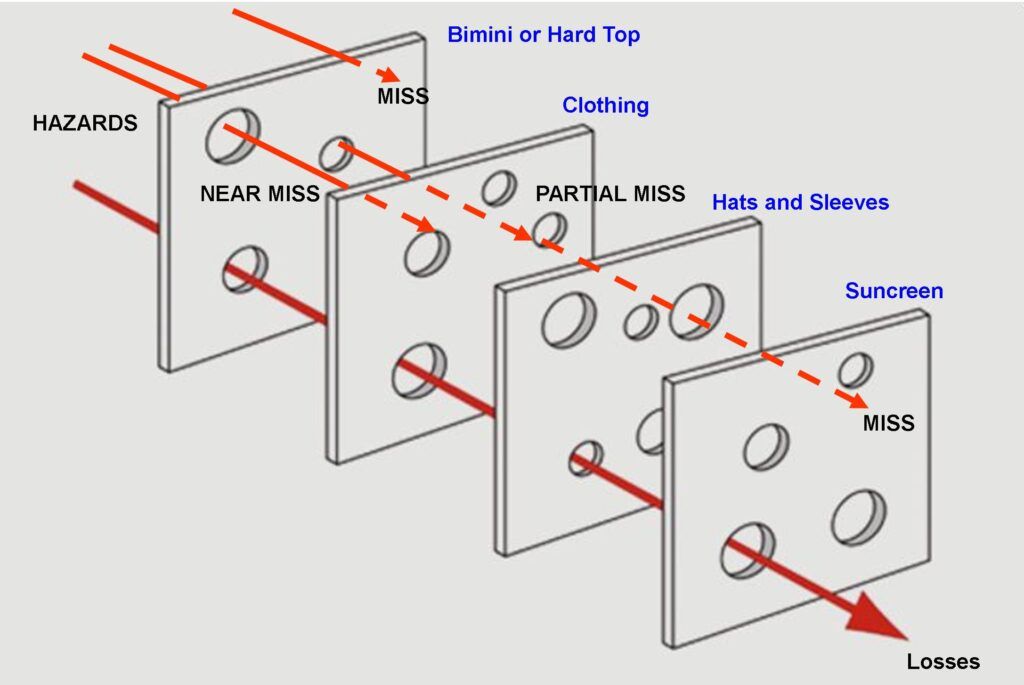
Another way to look at it is to favor engineered controls over practices. For example, compare the case of toxic chemical exposure to UV exposure:

Bottom line: If you want to avoid carcinomas or worse, you need to use shade, clothing and sunscreen.
Baseline Recommendations. The American Cancer Society and Skin Cancer Foundation both recommend sunscreen SPF and clothing UPF greater than 30 for protective clothing. Yes, you need some exposure for vitamin D production and general heath, but you only need an area the size of your face for a few hours per week. If you are an outdoors person, even in the deepest winter it is hard not to get enough sun. In the summer you will get more than you need running in and out of stores.
UV Index vs. Time of Day. Like solar panel output, UV exposure depends on the season, latitude and time of day. The angle reduces the irradiance per square foot in proportion to the sine of the angle; 45 degrees is only 71 percent of straight overhead. The atmosphere absorbs UV in greater proportion than visible light. Simply avoiding time in the sun for four hours before or after noon can reduce your exposure by 50 to 80 percent.
The earth wobbles about 23 degrees from summer to winter, so mentally transport yourself 10 to 20 degrees north to estimate off-season UV exposure. As a result, UV is pretty much nil in Annapolis mid-winter, for example, but not many people go sailing in a tee shirt and shorts in January either. That said, face and neck remain important in spring and fall. (Based on true noon, ignoring daylight savings time.)
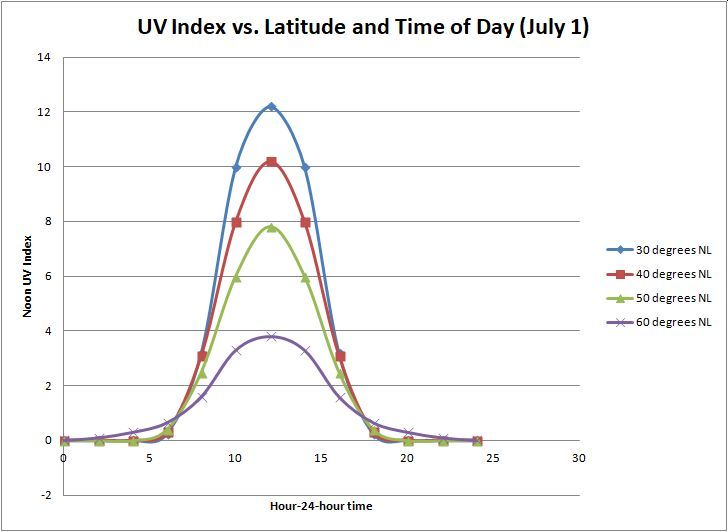
Testing. We calibrated our UV meter using layers of perforated metal screens of known free area (40%) to confirm linearity. Measurements were taken on at least four occasions, on days with UV index from 6 to 9.

SHADE
My first boats had naked cockpits and you baked. Reapplying sunscreen every two hours was a ritual, and scrubbing off the accumulation each night was an unpleasant reality, but it worked, sort of. Sunglasses and a hat with a neck flap was our fashion. My next boat was a cruising cat with a big hard top. We’d still apply sunscreen, but the urgency was less and reapplication less often; the UPF in the salon was more than 40 and generally 10 to 15 in the cockpit. Now that I’m sailing an open F-24, I’m in the sun again and covering up, except when heat and no-wind limits that. In the off-season, only the face matters, since no amount of UV will penetrate layers; a hat is obligatory for cold and a turtleneck covers my throat.
How much UV are you exposed to in the shade? It’s possible to burn in the shade, if the reflection is just so and you have no other protection (beaches are bad and high altitude snow is worse). Obviously, this depends on the colors of reflective surfaces and the sun angle, but as a rule it is 7 to 25 percent of the noon irradiance, equivalent to SPF 4 to 15 that does not wear off. Shade is an engineered control that works even when you are lazy, forget stuff and do everything wrong. For this reason, even though it is not quite enough on its own, a bimini or hard top is your best first line of defense. Bottom line: unless the design of the boat prohibits a bimini or hard top, or unless you are addicted to racing, get one. The weather protection tops raingear and the UV protection tops sunscreen.
Cockpit and Hatch Materials. All shade is not equal. White fabrics, including off-white Sunbrella, can pass 5 to 12 percent UV. Phifertex lets through about one third of the light that hits it, equivalent to a dismal UPF of just 3, so probably no more than UPF 2 under a Phifertex shade, once reflections are included.
Glazing materials also vary. Polycarbonate is inherently UV-blocking, while acrylic lets most UV through, and both do well when tinted. We were pleasantly surprised to learn (and measure) that clear vinyl dodger, bimini and sidewall panels provide a respectable 15 UPF, but disappointed that Makrolon windows (thin polycarbonate sewn into canvas) tested only 5 UPF.
CLOTHING
UPF-rated clothing has become a must-have among the cool kids, but what do all the numbers mean? SPF (sun protection factor for sunscreen) and UPF (ultraviolet protection factor for clothing) are very similar, but not exactly the same. SPF 10 means you can stay in the sun 10 times as long without reddening and UPF 10 means that 90 percent of the UVB is blocked. In practical terms, a given UPF provides greater protection because of the way it is measured and because it does not wear off.
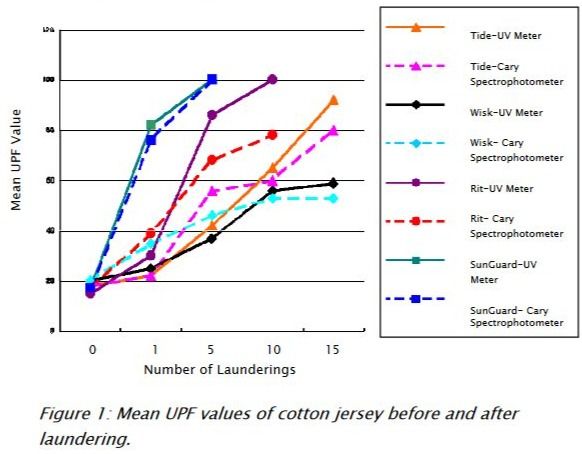
Tee-Shirts. White tee-shirts are widely said to have a UPF of 5 to 7 dry, and as low as 3 wet, but our data and the data of other independent researchers tells a very different story. Consumer Reports tested Hanes Beefy Tees (heavier than some tee-shirts) and got UPF 115 dry and UPF 39 wet. We tested a lighter Fruit of the Loom tee and got more than 40 UPF dry and 32 UPF wet. A University of Nebraska study reported UPF 20 to 40 dry before laundry and 80 to 100 after 5 to 10 times through the laundry (they tested the same slightly thinner Fruit of the Loom shirts we tested).
How can this be? First, we’re guessing the 5 to 7 UPF number was from the most sheer, feathery and unsuitable shirts they could find. Second, the process of laundering cotton tees dramatically increases the UV absorption value of the fabric. Most modern laundry detergents infuse “brighteners” into the garments, which are dyes that absorb UV and then reemit the energy as light in the blue range, sort of like day-glow fabrics. Any UV that is absorbed and converted to visible light is thus blocked. The more times the shirt is laundered, the greater the effect. The bottom line is that your old favorite is just fine and fabrics that turn see-through when wet may not be.
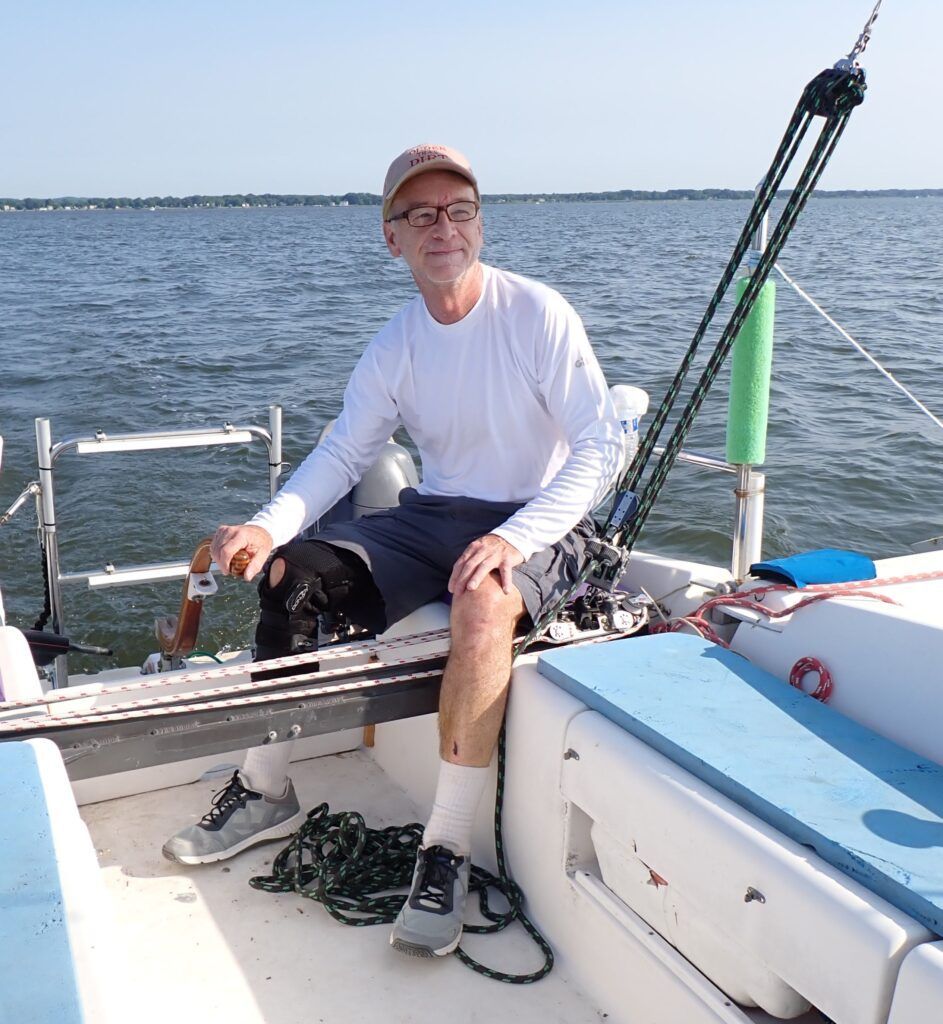
Want be more certain or to hurry the process along? SunGuard is a wash-in UV blocker based on the same brightener chemistry, but tweaked and more concentrated.
We checked independent reviews of UV-rated clothing. Uniformly, UPF results exceeded manufacture claims, so this seems to be one area where you can trust the ratings. Of course, this is not surprising, based on our tee-shirt research. It’s hard not to get a UPF 40 rating.
UV-specific features. Hoodies. I’m often told “I can’t sail unless I can feel the wind on my ears,” but winter sailors and those accustomed to hard tops and windscreens learn to use other cues—heel, the punch of a gust on the sails, the appearance of a cat’s paw moving across the water, wind indicators, telltales, and the look of the sails—to replace the feel of the wind on your face.
Thumb loops. A fabric loop prevents the sleeve from riding up and helps it cover the back of the hand. On the other hand, I wear gloves a good part of the time, and a thumb loop would interfere with that. It also leads to wicking of water up the sleeve (I have mid-layers with thumb loops) so I give this feature a thumbs down.
Bottom line: Judging UV protection is kind of like judging the wind resistance of fabrics (hold them tightly to your lips and blow). Hold the fabric up to the sun. If it hurts your eyes and you can see the world through it, the UPF is poor. If only the sun is visible, the UPF is tprobably 30 to 100. Colored Sunbrella is over 200 and denim is over 1500 UPF.
HATS
Most fatal melanomas start on the scalp, in part because it is sensitive, in part because it is highly vascularized, and in part because it is next to the brain. Diagnosis is often delayed because it is obscured by hair. A thick, dark head of hair can provide UV protection, but if it is blond, thin, gone, or in my case both, a hat is obligatory. Not mesh, no big holes, and not a sun visor. Sunscreen can also help, but a hat is easier and better.
I need several hats, not counting winter wear. For cool rain with light wind, I like my Gore-Tex Seattle Sombreo from Outdoor Research. It’s waterproof with a wide brim, and the fleece lining makes it warm and keeps it in place (backed up by a chin cord). For warm conditions, including light rain, any number of broad brimmed sun hats work. An overly wide brim catches too much wind, and a slight conical shape is more stable. Once the breeze comes up a ball cap becomes standard. My favorite has a bump cap insert; with growing waves comes the possibility of kissing the companionway or other hard object with my scalp (see “Protecting the Sailor’s Pumpkin,” July 2019). In between, I may reach for a cap with a neck flap (think Lawrence of Arabia) and larger brim.
How much shade is a hat? Up tight under the brim, high on the forehead is probably similar to open shade, about UPF 5 to 15. This is fortunate, because sunscreen does not work so well on the forehead. As for the face and neck, you need sunscreen.
SUNSCREEN
Great stuff, but it has a few flaws. Above the eyes is impractical. Sweat and spray will rinse it into your eyes, where it stings like mad and impairs vision, and this will happen at the worse possible moment. Apply sunscreen heavily across the nose, under the eyes and heavily on the ears and back of the neck. A hat brim and sunglasses protect the eyes and forehead.
Use enough. I know this is a broken record, but apply 1 to 2 ounces every 2 hours. If you spread it thin or apply it only once a day, your SPF 40 is probably SPF 10 at best. Maybe you don’t burn, but you are getting exposed. Put it on while you are packing to go, not at the boat. You will get busy and forget.
Sunscreen, Clothing and Heat. Does sunscreen actually make you hotter? Often debated, the research is mixed. Some have suggested it might inhibit sweat cooling as much as 5 percent, but most report no effect. How does bare skin compare to light fabrics, which also reflect sunlight, reducing radiant heat? In the desert, white breathable cloth is cooler. In the jungle, with high humidity, no wind and shade, bare skin wins out. In an open boat in the sun, even in very light winds, covered skin is cooler. In a breeze you’ll be fine either way (and covered skin is excellent sunscreen). Under the hard top in dead air, bare skin will rule, but you’ll need sunscreen.
But do high dollar sunglasses protect better than inexpensive glasses? No they do not. We tested a collection of drug store and tinted safety glasses, and they all tested greater than UPF 40. In fact, sunglasses sold in the U.S. are required by law to meet ANSI Z80.3 (greater than 100 UPF) and Z87.1 (impact protection). Some favor polarizing glasses to reduce glare. They are nice for looking over the water but are problematic reading LCD displays (you may have to tilt your head). Wrap-around glasses are best because they limit stray light, and larger lenses protect sensitive skin near the eyes where we don’t like to apply sunscreen. Reading glasses. The non-tinted reading glasses we purchased from drug stores and online used polycarbonate lenses and tested from UPF 20 to 30. However, the dollar store glasses we tested were made from something else and had a UPF of less than 2. This is also a risk in dollar store sunglasses which may not comply with U.S. law. Look for polycarbonate lenses. High end glasses are better built, feature better coatings and slightly better optics, but nowhere is shameless exaggeration in advertising more rampant than sunglasses. Before long, they all get salt spray on them. I’ve found quality safety glasses through industrial suppliers to be economical, rugged and very clear. They are also available with bifocals (zero correction on the top, the diopter of your choice from your prescription in the bottom third) for about $1 more. We like the DeWalt DPG59-220C Reinforcer for $11. They last a few seasons before with lose them. We buy three at a time and wear them driving, cycling and sailing. If high end is important to you, see “Practical Sailor Tests Polarized Sunglasses.”
Perhaps even more important than your skin are your eyes. Cataracts and other eye deterioration is hastened by UV, and you can’t face into driving rain or spray without them. If nothing else, your eyes get tired from squinting and infrared.
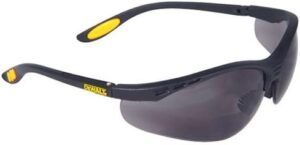
CONCLUSION
This started out as a review of UV clothing, but it quickly became apparent that any clothing that is not terribly sheer is going to have a UPF of greater than 30. What matters is combining shade, clothing and sunscreen in a logical way to limit exposure and reduce the risk of skin cancer.



























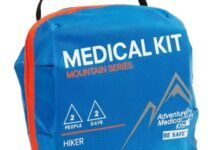




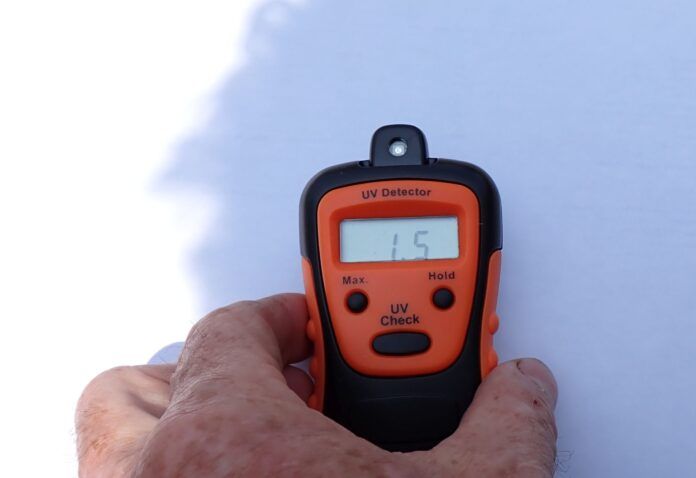





Drew, prove for yourself and your readers that SPF values do matter. Put 100 on one arm and that magic number 30 on the other.
The whole discussion will change and you can teach your dermatologist something as well.
In the paragraph headed Clothing, you say “and UPF 10 means that 90 percent of the UVB is blocked.” Then you go on, throughout the article, saying that higher UPF numbers are better than lower ones. Which way is it?
Both are true, but I can see how the definition is strange. UPF comes from sunscreen SPF. An SPF of 10 means you can be in the sun 10 times longer without burning, which for metabolic reasons is not exactly the same thing as blocking 90% of the UV, but similar in concept. UPF 10 blocks 90% of the sun. But is five times more effective, blocking 98% of the UV. Five times less UV gets through.
The important thing is to coverup, since even relatively low UPF values represent a great improvement over bare skin.
I guess my question is: from your UPF 10 – which one is better protection: UPF 20, or UPF 5?
We find that shirt sleeves with thumb holes and gloves together are not a problem. Contrastingly, regular sleeves and gloves always seem to either have a gap in protection, or tends to bunch up.
There is something to be said for the optical correctness of well-made sunglasses. This becomes even more difficult as lenses curve around the face for more protection. Bending distortions in one’s vision can add to fatigue overtime.
A pretty good article, but as a dermatologist, you make a good sailor. Way more fatal melanomas start on the back than the scalp and if the damn thing is going to get to your brain (as the bad ones often do!) it’s not by way of blood vessels, not from burrowing thru your skull!. What is true is that scalps, once exposed to UV (yes, I’m concerned with WE baldies) is VERY prone to developing squamous cell carcinomas, the second most common source of skin cancer fatality. HATS ARE ESSENTIAL if you can tan or burn on your scalp. Also, there is an excellent sunscreen for foreheads: Neutrogena 70 STICK. It does NOT get in your eyes and is good all day (a complicated subject. Best Buy in a sunscreen when properly used, Trader Joe’s spray (50) at $6
David Whitney, FAAD
I should proofread; melanomas get to your brain by way of blood vessels…
Tks a lot for so many well written and structured articles.
They are very informative and useful to me.
One detail got me quite worried 🙂
“earth wobbles about 23 degrees from summer to winter”
Really ? I’m sure that’s not what you meant. The earth we know would quickly be destroyed.
It is true that the earth has a precession cycle of about 26,000 years
Earth is tilted about 23.5 degrees on the plane of ecliptic.
This accounts for a total half-year apparent tilt of 47 deg. which explains the yearly vacation the sun takes to the southern hemisphere…
So the missing word was “apparent” wobble…
Sorry for being facetious !
Kind Regards
Alain (Eng. physics)
A comment from Vancouver Island. Our local dermatologist frequently rants and raves (he’s that sort of guy) that he often has to cut the tops off guys’ ears because they insist on only wearing baseball hats in the summer.
Kind Regards
Ken